

|
| DEUTSCHLAND | GERMANY |
| Bundesland: Freistaat Bayern | Bavaria |
| Regierungsbezirk: Mittelfranken | |
| Stadt: Nürnberg |
Nürnberg (Nuremberg) is situated at an elevation of 302 m at both sides of the river Pegnitz. Nuremberg is the economic and cultural centre of Franconia. With a population of about 500,100 (2006) is the second-largest city of Bavaria.
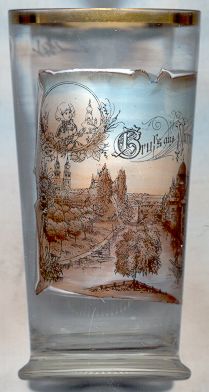
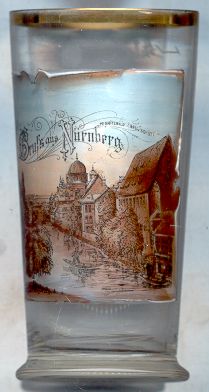 A document of Emperor Heinrich III, issued in 1050, is the first written mention of nuorenberc ('rocky mount').
Nuremberg castle soon became an important centre of the Holy Roman Empire. The "Großer Freiheitsbrief"
issued by Emperor Friedrich II granted the town the status of a Free Imperial city.
The city was ruled by a burgrave until 1427, when Burgrave Friedrich VI
(Friedrich I as Elector of Brandenburg since 1415/1417, temporarily Margrave of Brandenburg-Ansbach and Brandenburg-Kulmbach)
sold his title to the city council. Nuremberg was repeatedly visited by Emperor Ludwig IV ('the Bavarian'),
and also by Karl IV who issued the Golden Bull of 1356 here.
A document of Emperor Heinrich III, issued in 1050, is the first written mention of nuorenberc ('rocky mount').
Nuremberg castle soon became an important centre of the Holy Roman Empire. The "Großer Freiheitsbrief"
issued by Emperor Friedrich II granted the town the status of a Free Imperial city.
The city was ruled by a burgrave until 1427, when Burgrave Friedrich VI
(Friedrich I as Elector of Brandenburg since 1415/1417, temporarily Margrave of Brandenburg-Ansbach and Brandenburg-Kulmbach)
sold his title to the city council. Nuremberg was repeatedly visited by Emperor Ludwig IV ('the Bavarian'),
and also by Karl IV who issued the Golden Bull of 1356 here.
The Imperial regalia of the Holy Roman Empire were brought to Nuremberg in 1423 by Emperor Sigismund of the Luxembourg dynasty. The larger part of the regalia, the so-called 'Nuremberg Regalia', consist of the Imperial Crown of the 2nd half of the 10th century, the Imperial Cross of around 1024/1025, the Holy Lance of the 8th/9th century, the Imperial Sword of the 2nd third-part of the 11th century, the Imperial Orb of the late 12th century, the Coronation Mantle of 1124/1133, the Ceremonial Sword of 1220, the Eagle-dalmatic of before 1350, the Imperial Sceptre of the 1st half of the 14th century, Relics of the True Cross and other items. The so-called 'Aachen Regalia' (the Imperial Bible of the end of the 8th century, St. Stephen's Purse of the 1st third of the 9th century and the Sabre of Charlemagne of the 2nd half of the 9th century) were brought to Nuremberg from Aachen in 1794. In 1796 Emperor Franz II (1804 Franz I of Austria) ordered the evacuation of the regalia first to Regensburg and then to Vienna to protect them from being seized by France. In 1938 Adolf Hitler ordered their return to Nuremberg, but in 1945 they were returned to Vienna where they are again exhibited in the Treasury of the Imperial Palace.
The Reformation was introduced in Nuremberg between 1517 and 1523. The last Imperial Diet to take place in Nuremberg was held in 1543. After the Reichsdeputationshauptschluss of 1803, Nuremberg could at first retain its independence, but already in 1806 was occupied by French troops and was then incorporated into the new Kingdom of Bavaria.
In the 19th century, Nuremberg became an important industrial centre of Bavaria. The first railroad in Germany,
connecting Nuremberg with Fürth, was opened in 1835. During the Nazi period, Nuremberg was the site of the
Nuremberg Rallies (Reichsparteitage). During World War II, the city repeatedly was the target of Allied bomb raids.
Most of the historic old town was destroyed on 2 January 1945. After the war, the city was the site of the
Nuremberg Trials, two sets of trials of Nazis involved in World War II and the Holocaust. In the post-war period
the city was reconstructed, mostly following the historic ground plan.
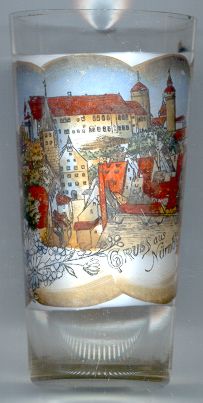
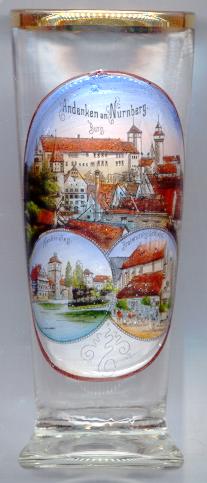
 Nuremberg castle, located above the northern edge of the old town, is the popular landmark
of the city. The castle actually consists of three, incompletely separated, parts: the 'Burgraves's castle' in the middle,
the 'Imperial castle' to the west of it, and further structures erected by the Free Imperial city on the northern and
eastern side. The castle was mentioned first in 1105. Between 1050 and 1571 all emperors of the Holy Roman Empire
paid a visit to the castle. In 1140 King Konrad III began to build a new castle which was meant to serve as
Imperial residence. When Nuremberg obtained the status of a Free Imperial city, the castle came in custody of the town.
The most prominet structure built by the city is the mighty tower "Luginsland", which was begun in 1377. During World war II
the castle suffered vast damages but was reconstructed after the war.
Nuremberg castle, located above the northern edge of the old town, is the popular landmark
of the city. The castle actually consists of three, incompletely separated, parts: the 'Burgraves's castle' in the middle,
the 'Imperial castle' to the west of it, and further structures erected by the Free Imperial city on the northern and
eastern side. The castle was mentioned first in 1105. Between 1050 and 1571 all emperors of the Holy Roman Empire
paid a visit to the castle. In 1140 King Konrad III began to build a new castle which was meant to serve as
Imperial residence. When Nuremberg obtained the status of a Free Imperial city, the castle came in custody of the town.
The most prominet structure built by the city is the mighty tower "Luginsland", which was begun in 1377. During World war II
the castle suffered vast damages but was reconstructed after the war.
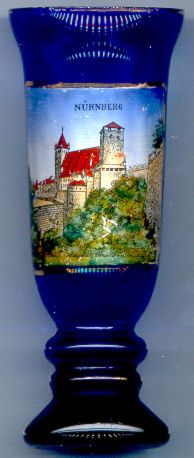
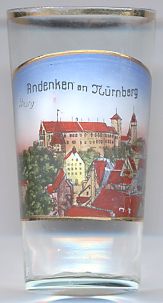
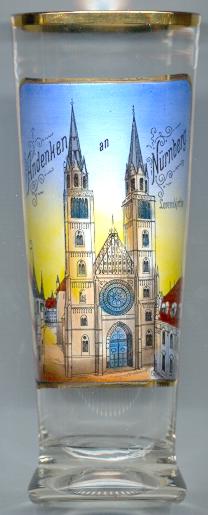
The  Lorenzerkirche (church of St. Lorenz) [left, no. 955]
is one of the important medieval churches of Nuremberg. The earliest mentions of a chapel dedicated to St. Laurentius
date from 1235 and 1258. The ground plan of this chapel could be partly determined by excavations in 1929. The church was heavily
damaged in World War II but was restored after the war. The most important treasures of the church are the tabernacle,
created in 1493–1496 by the sculptor Adam Kraft, and the 'Englischer Gruß' ('Anunciation'), carved by Veit Stoß
in/after 1518.
Lorenzerkirche (church of St. Lorenz) [left, no. 955]
is one of the important medieval churches of Nuremberg. The earliest mentions of a chapel dedicated to St. Laurentius
date from 1235 and 1258. The ground plan of this chapel could be partly determined by excavations in 1929. The church was heavily
damaged in World War II but was restored after the war. The most important treasures of the church are the tabernacle,
created in 1493–1496 by the sculptor Adam Kraft, and the 'Englischer Gruß' ('Anunciation'), carved by Veit Stoß
in/after 1518.
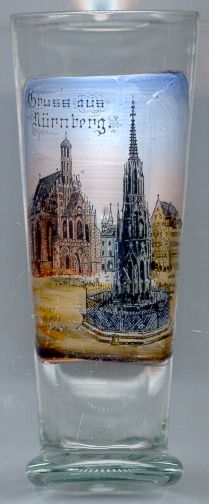
The  Frauenkirche (church of Our Lady) [right, no. 1625: background]
was built around 1360 (consecrated in 1358) on the site of an old synagogue that had been destroyed in 1349. In 1361 it was chosen
for the baptism in 1361 of Wenceslaus of Luxembourg, who already two years later, in 1363, was
styled King of Bohemia (Wenceslaus IV). The sacristy of the church was rebuilt in 1487. The western gable was created
by Adam Kraft in 1506–1508. In 1810–1816 the church was remodeled for its new use as Catholic parish church.
During World War II the church was almost completely destroyed; only the walls of the nave and the façade
had survived. The restoration to the original state was carried out between 1946 and 1953.
Frauenkirche (church of Our Lady) [right, no. 1625: background]
was built around 1360 (consecrated in 1358) on the site of an old synagogue that had been destroyed in 1349. In 1361 it was chosen
for the baptism in 1361 of Wenceslaus of Luxembourg, who already two years later, in 1363, was
styled King of Bohemia (Wenceslaus IV). The sacristy of the church was rebuilt in 1487. The western gable was created
by Adam Kraft in 1506–1508. In 1810–1816 the church was remodeled for its new use as Catholic parish church.
During World War II the church was almost completely destroyed; only the walls of the nave and the façade
had survived. The restoration to the original state was carried out between 1946 and 1953.
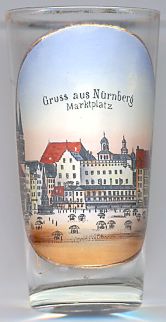
The  Marktplatz (Market Square) [left, no. 2357],
today named Hauptmarkt, is located in the Altstadt St. Sebald quarter, only a few metres north of the river Pegnitz.
It is the central square of the historic city of Nuremberg, its dimensions are approximately 90 x 90 meters.
The area originally was a marshy part near the river. In the 12th century the city council permitted the jews, who at that time came to Nuremberg,
to settle in this place. When around 1320 the city walls had been completed, the Jewish quarter now was situated in the centre of the town.
With permission of Emperor Karl IV, the Jews were expelled in a pogrom in which almost 600 of them were killed.
In place of the old ghetto two squares were laid out. One, the later Hauptmarkt, was originally called "Grüner Markt" (Green Market) or "Großer Markt"
(Great Market), the other one to the northeast, the "Obstmarkt" (Fruit Market). The site of the former synagogue was used for the construction
of the church of Our Lady (see above). The name "Hauptmarkt" was officially introduced in 1809 or 1810.
Marktplatz (Market Square) [left, no. 2357],
today named Hauptmarkt, is located in the Altstadt St. Sebald quarter, only a few metres north of the river Pegnitz.
It is the central square of the historic city of Nuremberg, its dimensions are approximately 90 x 90 meters.
The area originally was a marshy part near the river. In the 12th century the city council permitted the jews, who at that time came to Nuremberg,
to settle in this place. When around 1320 the city walls had been completed, the Jewish quarter now was situated in the centre of the town.
With permission of Emperor Karl IV, the Jews were expelled in a pogrom in which almost 600 of them were killed.
In place of the old ghetto two squares were laid out. One, the later Hauptmarkt, was originally called "Grüner Markt" (Green Market) or "Großer Markt"
(Great Market), the other one to the northeast, the "Obstmarkt" (Fruit Market). The site of the former synagogue was used for the construction
of the church of Our Lady (see above). The name "Hauptmarkt" was officially introduced in 1809 or 1810.
The  Schöner Brunnen [right, no. 1625: foreground],
in the form of a Gothic church spire (19 m tall), was created in 1385–1396 by Heinrich Beheim.
Throughout the centuries, the piece was renovated and rebuilt several times.
What we see today is a copy of 1912; the few surviving parts of the original are exhibited in the Germanisches Nationalmuseum
of Nuremberg.
Schöner Brunnen [right, no. 1625: foreground],
in the form of a Gothic church spire (19 m tall), was created in 1385–1396 by Heinrich Beheim.
Throughout the centuries, the piece was renovated and rebuilt several times.
What we see today is a copy of 1912; the few surviving parts of the original are exhibited in the Germanisches Nationalmuseum
of Nuremberg.
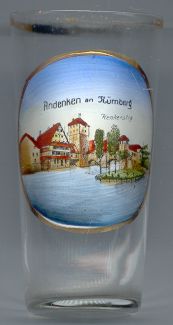
The  Henkersteg ('Hangman's Bridge') [left, no. 1628]
spans the southern branch of the river Pegnitz. The pedestrian bridge was erected in 1457. Its name is derived from
the fact that the neighbouring tower was the historical accomodation of the executioners. The original footbridge
was damaged by a flood in 1595 and was rebuilt a little further west of its original site.
Henkersteg ('Hangman's Bridge') [left, no. 1628]
spans the southern branch of the river Pegnitz. The pedestrian bridge was erected in 1457. Its name is derived from
the fact that the neighbouring tower was the historical accomodation of the executioners. The original footbridge
was damaged by a flood in 1595 and was rebuilt a little further west of its original site.

The  chapel of St. Moritz [near left, no. 2433: bottom left picture]
was built in the 14th century and was located just north of the church of St. Sebaldus.
Unlike other churches, the chapel of St. Moritz was spared the destruction after the incorporation in 1806 into the kingdom of Bavaria.
but a few years later it only was used as a hay barn for the army and as timber yard. In 1828 King Ludwig I visited Nuremberg and
chose the chapel as the site for a new exhibition venue for a state-owned galery of old German paintings. In 1829 this collection,
which was open to the public for free, was opened. In 1882 the collection was finally moved to the Germanic National Museum of Nuremberg
which had been founded in 1852. After 1882 the chapel again served for religious purposes. Renovation works were carried out in
1908–1912 and 1924/1925. Further works began in 1937 and continued even during World War II. However, on 3 October 1944
the chapel was completely destroyed by an Allied bomb raid.
chapel of St. Moritz [near left, no. 2433: bottom left picture]
was built in the 14th century and was located just north of the church of St. Sebaldus.
Unlike other churches, the chapel of St. Moritz was spared the destruction after the incorporation in 1806 into the kingdom of Bavaria.
but a few years later it only was used as a hay barn for the army and as timber yard. In 1828 King Ludwig I visited Nuremberg and
chose the chapel as the site for a new exhibition venue for a state-owned galery of old German paintings. In 1829 this collection,
which was open to the public for free, was opened. In 1882 the collection was finally moved to the Germanic National Museum of Nuremberg
which had been founded in 1852. After 1882 the chapel again served for religious purposes. Renovation works were carried out in
1908–1912 and 1924/1925. Further works began in 1937 and continued even during World War II. However, on 3 October 1944
the chapel was completely destroyed by an Allied bomb raid.
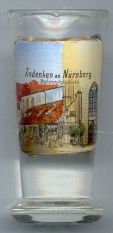
The  Bratwurstglöcklein [right, no. 1322] is the oldest sausage kitchen in Nuremberg,
mentioned first in a document of 1313. Its original site was at the northern side of chapel of St. Moritz where it remained until the
destruction of the chapel in 1944. Today, a restaurant
of this name is located in the Handwerkerhof.
Bratwurstglöcklein [right, no. 1322] is the oldest sausage kitchen in Nuremberg,
mentioned first in a document of 1313. Its original site was at the northern side of chapel of St. Moritz where it remained until the
destruction of the chapel in 1944. Today, a restaurant
of this name is located in the Handwerkerhof.
![[scale]](lineal.jpg)